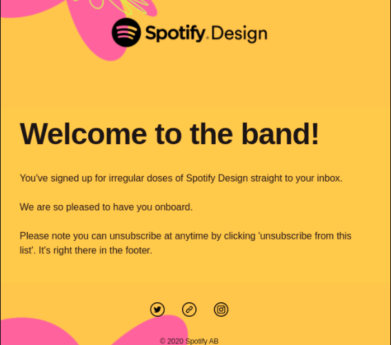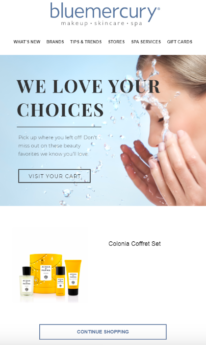Email marketing campaigns are hugely beneficial, but selecting the right one for your needs can be daunting. Here we share an article by Melinda Miley from Brafton which breaks down 9 types of email marketing campaigns that you can master.
From video campaigns to social media posts, there are plenty of ways to connect with consumers these days. While email marketing may be one of the oldest messaging channels, it still reigns as one of the most effective ways to get in touch with target audiences. According to HubSpot, emails produce a 4,200% ROI by generating $42 for every $1 spent, making email marketing the highest-ROI channel.
That said, email marketing campaigns have endless applications for businesses of all sizes. Let’s dive into how to create an effective email marketing campaign for your company and the various types of emails your brand should be sending.
How to Leverage Email Marketing Campaigns
Before we dive into the different types of email marketing campaigns you need to try this year, we should first define what exactly an email marketing strategy is. Your email marketing strategy should be an organized list of action items that support your brand’s desired marketing goals — such as increasing brand awareness, conversions, or consumer touchpoints.
Having an email marketing strategy in place is essential for 3 core reasons:
- It aligns email campaigns with overarching business goals.
- It defines email marketing objectives, so you can be sure to provide value every step of the way.
- It enables marketers to evaluate the effectiveness of their emails.
An important part of developing an email marketing strategy includes identifying the goal of each campaign. Every email you deploy should have a target objective in mind, such as:
- Informing: Send updates on new product launches, provide company-related information or supply educational materials that your target audience will find interesting or helpful.
- Engaging or re-engaging: Use email marketing to connect with prospects or re-engage subscribers who may not have interacted with your brand in a while.
- Nurturing: Leverage emails to establish consistent touchpoints and turn a new customer into a lifetime supporter of your business.
- Converting: Direct email recipients to perform a specific action, such as visiting your website, completing a contact form or making a purchase with a promo code.
Once you have a strategy in place and a goal defined, you can start creating your email marketing campaign.
9 Email Marketing Campaigns To Try This Year
Before you dive into creating your next big email campaign, brainstorm which types of emails you want to include. Here are 9 of our top picks to consider:
1. The Welcome Series
You’ve locked in a new email subscriber — congrats! Now’s the perfect time to say hello and launch the beginning of a long-term relationship. The welcome email is an opportunity for you to engage new subscribers, encourage them to interact with your brand or convince them to take action, like visiting your website. And when it comes to open rates, Invesp found that welcome emails generate 4 times more opens and 5 times more clicks compared to standard marketing emails.
 When drafting your welcome email, there are a few key elements to include:
When drafting your welcome email, there are a few key elements to include:
- A clear, concise and engaging subject line.
- A personalized greeting.
- Steps for the recipient to take action.
- Links to your website, blog or social channels.
Don’t forget: Timing is everything when it comes to welcome emails. Taking too long to contact a new subscriber can cause them to forget about you. Consider utilizing email automation so that as soon as someone signs up, they promptly receive a welcome email in their inbox.
Here’s a great example of a Spotify welcome email.
2. Sales and Promotional Emails
The most common emails are sales campaigns. Whether you’re promoting a new product, highlighting a sale or trying to generate a conversion, these emails are important to incorporate into your email marketing strategy. However, inboxes can easily become cluttered, so you need a campaign that stands apart from the others. A few ways to ensure that is by:
 Featuring a strong subject line and call to action.
Featuring a strong subject line and call to action.- Keeping your email body short, sweet, and straight to the point.
- Providing deadlines to add a sense of urgency.
- Using email technology to personalize the content as much as possible.
Additionally, you can offer a promotional email code specifically for the recipient. Not only can this encourage readers to take action, but you can use the code to track how successful your emails were. Here’s an example of a promotional email with a code sent from the apparel store Express.
3. Seasonal Emails
Changing seasons may call for a wardrobe change, but they can also be the perfect opportunity for sending an email to your subscriber list. Seasonal campaigns coincide with a specific holiday or a new season, such as an apparel store promoting bathing suits at the start of summer. As for holidays, the National Retail Foundation reports that some of the highest consumer-spending holidays in the U.S. in 2021 included Father’s Day, Valentine’s Day, Graduation season and Halloween. So whether you’re hosting a spring cleaning event, a new year’s promotion or a summer blowout sale, let the changing seasons be a reason to connect with your customers via email.
4. Post-Purchase Campaigns
Not only is it vital to send emails to encourage a sale, but you also want to touch base with your clientele after they’ve made a purchase. Why? Post-purchase campaigns provide an opportunity to:
- Confirm their order and issue a confirmation or tracking number.
- Thank the customer for their business, encourage future sales and bolster brand loyalty.
- Provide an opportunity for feedback on their experience with your brand.
- Send similar products or promotional offers that can motivate them to do business with you again in the future.
Essentially, your post-purchase emails should be automated by triggers, so you know every customer receives one promptly after making a purchase.
5. Cart Abandonment Emails

Abandoned cart campaigns are exactly like they sound: They engage with customers who recently visited your website and placed items in a cart but never finished the sale. According to research by Moosend, consumers open 45% of cart abandonment emails. Of those opened emails, 50% of recipients end up completing the purchase. With those stats in mind, running cart abandonment campaigns is a must for online and e-commerce brands.
So what should your cart abandonment email include? Getting the copy right is critical for success. Incorporate clear messaging that alerts customers that there are still items in their cart and that they need to complete their order ASAP. For extra motivation, you may want to add an extra prompt — such as free shipping — to ensure the recipient completes the sale.
Here’s an example of a cart abandonment email from Bluemercury.
6. Retargeted Emails
Also known as email remarketing, retargeted emails are sent to people who engaged with your brand — whether through the website, social media or another medium. These people are customers or email subscribers who might need a lil’ nudge to encourage a sale.
For instance, you may be able to track a user that visited a specific page of your website. You can then deploy a retargeted email listing the products they were looking at or highlight similar products that may appeal to their interests. By keeping your brand top-of-mind — as well as at the top of their inbox — you’ll be able to encourage more sales and increase conversions.
7. Trigger Email Campaigns
Triggered emails are sent automatically. Marketers can select pre-determined qualifiers based on user behaviors. Once a shopper performs these specific functions, the trigger email gets deployed.
Examples of common triggers for these types of email campaigns include:
- Completing an order.
- Subscribing to an email list.
- Milestone emails — such as gaining a certain number of reward points or completing a specific number of purchases.
- Birthdays or customer anniversaries.
Ultimately, a trigger email may contain similar messaging as a promotional or sales email. But the key difference is that these emails are automatic and delivered to specific individuals based on specific behaviors. Promotional emails are typically deployed to large groups of consumers at once and based on the marketer’s decisions, rather than an action.
8. Brand Story Emails
Emails don’t always have to center around transactions. Brand story emails can increase subscriber engagement and bolster your relationship with your subscribers. Use a brand story email to tell the history of your company, highlight your company’s journey, share future goals or shed a spotlight on the people who work at the business. Whether you’re a startup firm or have been selling goods for over a century, a brand story email can help you convey your unique selling proposition, values and mission to your subscribers, thus building a stronger connection between your brand and its customers.
9. Update Emails
Whether you’re launching an entirely new product or adding features to your website, share the news with your email list. Update emails spread the word on the latest innovations your brand is implementing as well as solidify your commitment to enhancing the customer experience and making continuous improvements.
Check out this example of an update email sent from Groove HQ’s CEO about their latest product updates.
To read this article in its original format or download the checklist template, check out brafton.com.
For a strong start to your email marketing campaign, you need reliable contact data.
Luckily, the Kompass EasyBusiness database boasts 12 million executive emails in 60+ countries.
EasyBusiness by Kompass is a powerful marketing and segmentation tool with:
- Over 20 million business profiles in the United States and 60 million worldwide.
- Multi-contact tool that allows you to send emails to multiple companies and executives with one click.

- Reliable and accurate contact information for companies and executives worldwide with over 11.9 million corporate emails, 8.7 million executive emails, and 33 million phone numbers.
- More than 60 search criteria to search with on our search engine. These include simple criteria like industry and location, but also more detailed criteria, such as turnover rates.
Easy is in the name! EasyBusiness‘s intuitive interface accompanies you from A to Z. You can easily enrich, sort, and even export your business data in the file formats you want. Add personal notes to follow up on your targeted prospects and analyze your search results through tables and diagrams in a few clicks.
If your company is going global, looking for new suppliers, or trying to reach new clients, EasyBusiness can provide you with all the data you need. To learn more about our multi-contact feature and about our EasyBusiness tool, reach out to us!







 Featuring a strong subject line and call to action.
Featuring a strong subject line and call to action.





Comentarios
No Comments